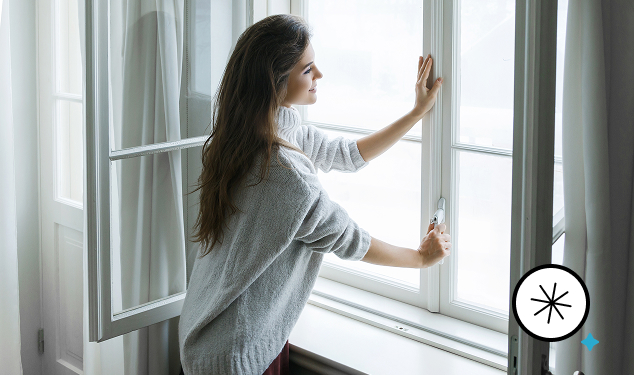When it’s cold outside, windows can be a major source of heat loss in your home if they’re not properly insulated. Learning how to winterize windows can significantly reduce drafts, save on energy bills, and make your home more comfortable. In this guide, we’ll explore practical step-by-step tips explaining how to winterize windows to keep the cold out and the warmth in.
1. Identify Air Leaks
The first step in learning how to winterize windows is to check for air leaks. Even small gaps around windows can lead to significant heat loss. Once you’ve assessed where the leaks are, then we’ll move on to potential solutions.
- Conduct a Visual Inspection: Look for visible cracks or gaps where the window frame meets the wall. On a windy day, you can also feel around the edges of your windows to detect drafts.
- Use the Candle Test: Hold a lit candle near the edges of your window. If the flame flickers, you’ve found a leak.
2. Install Weatherstripping for Extra Protection
Weatherstripping is an affordable and effective way to start winterizing your windows with some increased insulation. You can apply these simple materials yourself and they manage to keep out drafts while still allowing the window to open and close smoothly. Here are three of the best ways to winterize and weatherstrip windows.
- Seal with Caulk: For gaps around window frames, use exterior-grade caulk to seal the openings. Apply it in a continuous bead and smooth it out to ensure it fills the entire crack.
- Adhesive Foam Strips: Foam weatherstripping is easy to apply. Just measure the length of your window sashes, cut the strips to size, and apply them along the edges to form a tight seal.
- V-Strip Weatherstripping: V-strips, also known as tension seals, are more durable and can be applied along the sides of window sashes. They’re a great option for winterizing windows that get frequent use.
3. Window Treatments and Add-Ons
If you need an extra layer of protection against air leaks, there are a few temporary yet effective solutions to help you winterize your windows. These methods are especially useful when winterizing windows in older homes where replacing them may not be an immediate option.
- Cellular Shades: Cellular or honeycomb shades trap air in their unique design, creating an insulating layer between your windows and the room. They’re a stylish and functional way to reduce heat loss.
- Thermal Curtains: These heavy, insulated curtains help block cold air from entering your home and prevent warm air from escaping. They are particularly useful at night when temperatures drop.
- Window Insulation Film: This clear plastic film is applied to the inside of your window frame using double-sided tape. Once in place, you shrink the film with a hair dryer to create a tight seal. This simple step adds a layer of insulation, reducing heat loss.
- Storm Windows: If you live in a particularly cold area, consider installing storm windows. These can be fitted over your existing windows to provide an extra barrier against the cold. While storm windows are a larger investment, they’re highly effective and can also improve your home’s energy efficiency in the long term.
If you’re wondering how to winterize old windows with a more permanent solution, replacing them with energy-efficient windows provides comfort and lowers your energy bills. It can also add value to your property, making it a worthwhile investment.
- Double or Triple Pane Windows: These windows contain multiple layers of glass with gas-filled spaces between them, which improves insulation and reduces heat transfer.
- Low-E Glass: Low-emissivity (Low-E) glass has a special coating that reflects heat back into the room, keeping your home warmer during winter.
By following these steps to winterize windows, you can keep the cold out, reduce your energy bills, and enjoy a cozy home all winter long. For more in-depth tips on window insulation and home efficiency, explore additional resources on Edwix.





